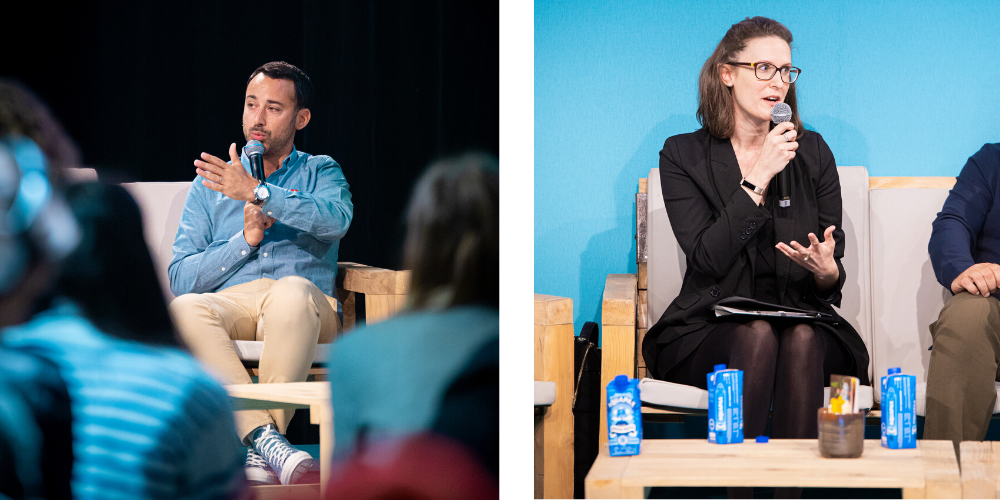SECOND-HAND CLOTHING: THE LUXURY OF TOMORROW ?
Trends
IMPACT talk about the second-hand market
What are you wearing today? A small observation is in order. What are you wearing? What brand? What season? What manufacturer? Where was it made? These are questions that weren’t really asked before, but now are becoming real questions in the consumer’s daily life. Other than politics, agri-food and cosmetics, sustainability is now inviting itself into our lives. The ethical side of clothing is becoming a pledge of quality, even more so: a source of desirability. What’s more ethical than second-hand? This is the question that Camille Greco from Crush On , Carina Hopper from Lablaco and Bruno Vanhove from Disruptual were discussing, mediated by Pierre-Nicolas Hurstel from Arianee.

In 2018, the second-hand clothing market was worth 21.2 billion euros. In 2023, it will be worth 45 billion euros. Furthermore, some analysts have predicted that it will surpass the luxury market by 2022 and that of fast fashion in 2028. These figures testify to the real tidal wave of second-hand clothing in the fashion industry. “The industry is creating a new distribution system to adapt to the evolving consumer values and behaviour,” explains Bruno Vanhove, Commercial Director of Disruptual. In recent years, the "True Cost" of fashion has been reversed, as already demonstrated in 2013 with Andrew Morgan's shock documentary. A health, environmental and human cost. Faced with the demands and shortcomings of this globalized fast-system, there was already concern about the fast pace of collections, massive overproduction and excessive waste that strictly encompassed the "take, make, dispose" model. Now, the eco-responsibility principle is at the heart of the purchasing principle, thus putting the essence of fashion at the centre of the value chain: the world and the population.
This new fundamental movement is present at all levels of society, putting the second-hand market back at the heart of the purchasing dynamic, as shown by the profitable image of Emmaus, Super Marché, Vide Dressing and Vestiaire Collective, to name but a few…Thrift shops, second-hand and e-shops, reselling clothes is everywhere and definitely trendy. Succeeding in making second hand clothes trendy was also the aim at Crush On and their founder Camille Greco which offers an original selection of cutting-edge second-hand clothes and eco-friendly design. Like the whole generation of designers and brands, Camille wants to slow down the current production model which is “too polluting and degrading in human and ecological terms,” with unfailing creativity and well-established determination. Now, brands and consumers are working side by side to promote a fairer system.

“Second-hand clothing has been around since the dawn of time,” emphasises Bruno Vanhove. Many factors have played a part in its rising popularity in recent years. One of them is ecological, reducing the impact of clothing on the planet but it is above all economic: being able to buy an item at 80% off and providing access to high-end items. Purchasing second-hand clothes allows all fashion lovers, regardless of their budget, to buy popular, good quality older styles, that would otherwise not have been available. But one of the main reasons for the success of this new resale system is undoubtedly the development of e-commerce and the digitalization of the market. Second-hand clothing has become so democratic thanks to the internet. The reputation of Le Bon Coin, which has been listed on the stock market since the beginning of 2019, or of Vinted, its biggest rival, now show the power of these new sites, which are capable of overturning the system. So there is a booming second-hand market especially between individuals whilst brands and luxury market are being overtaken by various collection services, upcycling, clothes repairs and recycling programmes…
The second-hand market has now become a definite future for the fashion industry and it is reaching the highest levels. An alternative trend that is not at all marginal and is continuing to improve its services and visibility over the years. Beyond the economic side of things, second-hand clothing is creating new sustainable values for consumers. Moreover, it promises a system founded on uniqueness and rarity so that the consumer can now dress differently and stand out. So, has second-hand become the luxury of tomorrow?